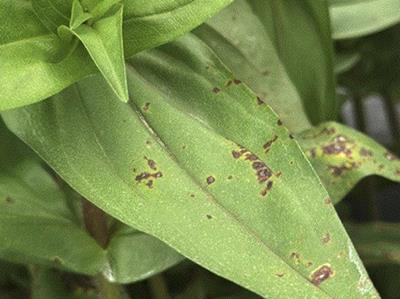This week growers are seeing leaf spots in a few different crops. Here's what to look for, some tips for identification, and various methods of control.
PROBLEM: The latest heat wave of the season has kept physiological stress levels high for outdoor-grown crops. When the weather is so hot, many growers are forced to irrigate their crops more frequently. If high temps are accompanied by lots of rainfall, this can provide some temporary relief, but it also opens the door to other issues. For growers who can only water overhead, high temps and lots of moisture in the canopy can be equally problematic, because these factors combined often lead to incidences of bacterial leaf spot (BLS).

NICK’S TIP: With several recent reports of BLS in crops like garden mums and zinnia, be sure to keep an eye out for symptoms in your crops and stay ahead of disease pressure.
Which Bacterial Leaf Spot Is Which?
Xanthomonas spp. and Pseudomonas spp. are most often the cause of BLS in different crops, but they are often very host-specific pathogens. This means BLS in one crop is very unlikely to affect another crop nearby that is not in the same genus or species (depending on the bacterial pathogen).
For garden mums, Pseudomonas chicorii is the causal agent of BLS.
• This pathogen is primarily a soilborne bacterium and needs warm temperatures (about 68–82F [20–28C]) and free moisture on leaves and/or stems to infect and cause disease.
• Infection often occurs when bacteria in the soil splash up into the canopy during rain or overhead irrigation events.
• Poor sanitation practices are typically what allow this bacterium to get into your operation, but it can also enter on infected cuttings or liners.
Typical BLS (on garden mums) symptoms include:
• Water-soaked spots on the foliage and/or stems that develop tan/brownish centers as disease progresses. Lesions sometimes have a yellow halo and are irregular in shape.
• As disease progresses, lesions become sunken in appearance, dark discoloration in leaf veins can occur, and heavily infected plant parts may wilt as disease severity increases.
For zinnia, Xanthomonas campestris pv. zinniae is the causal agent of BLS.
• Initial source of bacteria is often seedborne or via contaminated plant material. As such, plants should always be treated as though disease is present. See our At-Risk Document and On-Demand Video for more info.
• This pathogen also prefers high heat and can proliferate at temperatures up to 95F (35C) when free moisture in the canopy is abundant.
• Infection can occur shortly after germination if seedborne bacteria are present or via splashing bacteria from adjacent plants.
• Similarly to Pseudomonas, poor sanitation practices and presence of bacteria in leaf litter can facilitate repeated incidences of disease within a season. However, failure to apply appropriate preventative bactericides is often the biggest factor when disease occurs.
Symptoms of BLS in zinnia often include:
• Dull, grayish spots on leaves that develop into yellow or tan spots as bacteria advance from the point of infection. As lesions grow, spots become dark brown in color and coalesce.
• Coalesced lesions may appear angular, which often lead growers astray, thinking they are dealing with Alternaria leaf spot. The best way to confirm whether you have BLS or Alternaria in your crop is to consult a diagnostic lab or look for bacterial streaming from lesions under a microscope.
Management of BLS
Outbreaks of BLS often occur in mid to late summer—right about now! Scout crops diligently and pay close attention to anything that might appear to be early symptoms from late July through early September.
• To reduce risk, use drip irrigation in crops like mums, large-container summer zinnia programs, or cut-flower zinnia beds whenever possible. This will greatly reduce the potential for spread via splashing water. That said, it is impossible to control rainfall in outdoor production spaces, so it is critical to stay on top of other BMPs to reduce risk further.
• Maintain strict sanitation protocols in your production areas and ensure that employees wash their hands frequently. Sanitize tools regularly when moving between crops and clean up plant debris and other organic residues in your growing spaces to eliminate potential bacterial reservoirs.
• Space crops appropriately to facilitate adequate air flow. This will help reduce the amount of time that free moisture remains in the canopy and reduce the chances of infection or spread of BLS.
Use of preventative bactericides is critical when the weather forecast says it’s going to be hot and wet for extended periods.
• Copper-based products (ex. Badge, Camelot, EcoSwing, Phyton, etc.) or copper + mancozeb tank mixes are an effective, chemical management approach.
• Bio-based products like Cease, Triathlon or Stargus are other good preventative options.
Unfortunately, there are no curative treatments for BLS, so it is best to rogue out infected plants as they are identified. Throw affected crops away—do not compost symptomatic plants. Treat healthy, asymptomatic plants nearby with an appropriate bactericide and, out of an abundance of caution, maintain preventative sprays for at least two to three weeks after no new symptoms are observed in the crop.